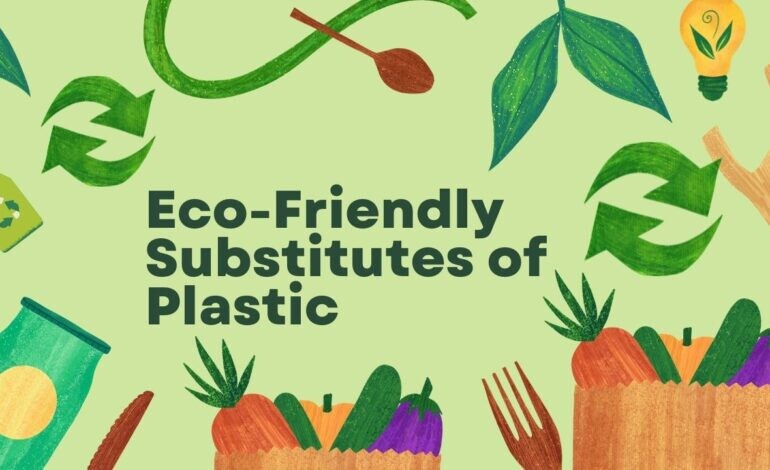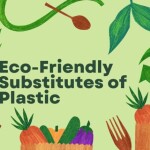Every year, 5 trillion single-use plastic bags are used worldwide, and it takes a bag a thousand years to degrade. Annually, more than 10 million tonnes of plastic reach the ocean. By 2050, the Earth will be covered in 12 billion metric tonnes of plastic waste, which we must stop doing. The good news is that, according to the United Nations, governments in at least 127 nations have established regulations governing plastic bags, and at least 32 countries have outright banned them. Around the world, many nations are enacting plastic bans and urging people to switch to alternative materials like biodegradable single-use items and eco-friendly reusable products in favour of plastic.
Why do we require plastic substitutes?
Plastic does not degrade or break down at all, while being extremely resilient and durable. Even if it does (after roughly 600–800 years), microplastics from it continue to exist in our environment. They are essentially smaller pieces of plastic that dissolve into our soil and water and seriously harm plant, animal, and human health.
To develop environmentally appropriate replacements for plastic, a lot of work and effort must be put out. Although it is obvious that plastic has numerous uses, it is challenging to find a plastic that does not harm the environment.
What are the best plastic substitutes?
We can utilise a variety of methods on a daily basis to cut down on the amount of plastic we use. While the majority of these demand a one-time investment, over time they wind up saving both money and the environment. The most popular substitutes for plastic in daily life include the following:
1. Glass

Glass is a non-biodegradable inert substance that is suitable for food, but it really does last a long time. Pickles, jams, and other foods are also stored in it, and it is extremely recyclable. Glass jars may also offer our kitchen a fantastic facelift, making it appear neat and organised.
2. Stainless steel

Stainless steel is a sturdy, resilient, and long-lasting substance. You can use steel containers in place of plastic takeout containers and steel straws in place of plastic ones, which are known to cause great harm to marine life. Steel dishes and silverware are an extremely efficient exchange that reduces the use of plastic significantly.
3. Silicone

Flexible silicone is a substance that can be used in both food and medicine. Silicone is also used to make menstrual cups. These days, silicone is used in many culinary items since it can withstand heat to some level.
4. Beeswax

Beeswax has the ability to resist water. Beeswax-coated cloths are increasingly common these days because they can be used as an alternative to cling film, a very thin plastic wrap used to keep food safe. Fabric with a beeswax coating is simple to use and simple to maintain.
5. Natural Fibers

Fabrics made of organic cotton, hemp, and jute can be used in place of synthetic ones. These materials stay longer than the artificial synthetic materials that are so easily accessible, in addition to being incredibly comfortable and kind on the skin. When they are entirely worn out, clothes composed of these materials can also be composted.
6. Bamboo and wood

We merely need to start using these two materials again because they have been there for a very long time. Bamboo is an easily grown plant, and bamboo toothbrushes and straws help reduce the amount of plastic that ends up in landfills and the ocean.
7. Ceramics and clay

As many kitchen tools are made of clay and ceramic, this alternative is also healthier for you and simple to implement.
8.Cardboard and paper

Handmade paper is a superior substitute for shiny wrapping paper that is essentially plastic, and it also looks incredibly lovely. Plastic boxes can be easily replaced by cardboard boxes, and both of these materials may be composted easily, resulting in zero waste.
Additionally, some bioplastics can be utilised in place of polymers made artificially. These solutions do exist, but they are difficult to find and do not compost easily. They must be broken down under particular heat and weather conditions. We advise you to completely avoid using plastic in place of choosing these.
How do we break our dependence on plastic?
Habits are challenging to overcome, particularly when convenience is the driving force behind many of your decisions. Breaking some of your convenience-driven habits will undoubtedly assist if you care about the environment and want to do your part. Take one modest step each day and be gentle to yourself as well. Even something as simple as declining a plastic straw at your neighbourhood juice bar could count.
From there, you can gradually advance to slightly bigger actions like bringing your own food and coffee containers. Even while carrying your own cloth bag when shopping for vegetables may seem like a big step, it helps to reduce the amount of plastic bags dumped in landfills and the ocean. We all need to realise the true price of ease at some point. Our planet and the following generations must bear the cost.









